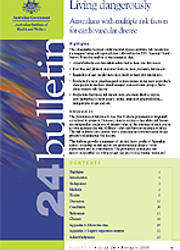Summary
The prevalence of risk factors (see Box 1) in the population is frequently considered in isolation. However, there is evidence that while risk factors are independent predictors of disease—that is, the presence of each one on its own increases the risk of illness—they also have an interactive effect. The risk of illness for a person with a particular factor is increased by the presence of additional risk factors.
This bulletin provides a summary of the risk factor profile of Australian adults—focusing on risk factors for cardiovascular disease—both individually and in combination. The prevalence of multiple risk factors is described according to age, sex and socioeconomic status and cardiovascular disease—derived from self-reported data collected in the 2001 National Health Survey (NHS)—in order to identify population groups most at risk.
Highlights (168K PDF)
Background (221K PDF)
Methods
Results
Discussion (154K PDF)
Conclusion
Appendixes:
Appendix 1: About the data
Appendix 2: Logistic regression analysis
End matter: References; Glossary; Acknowledgments



